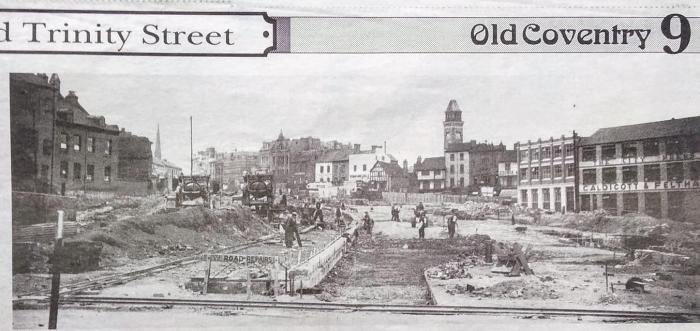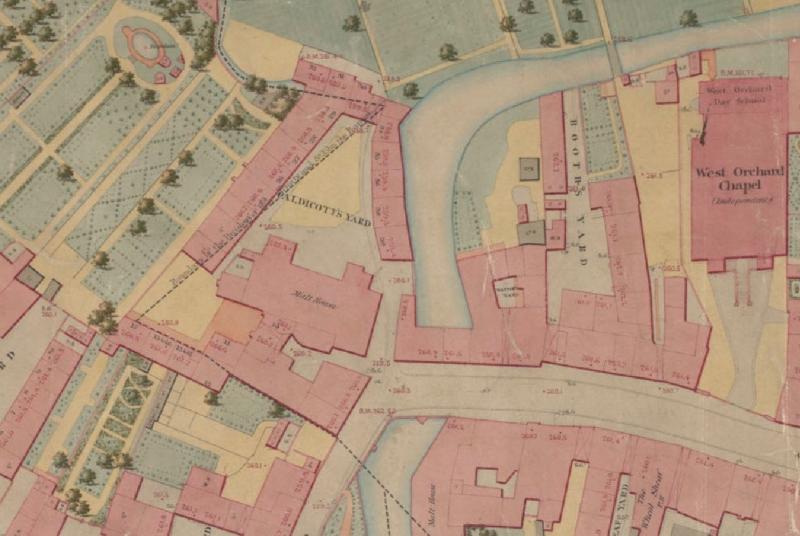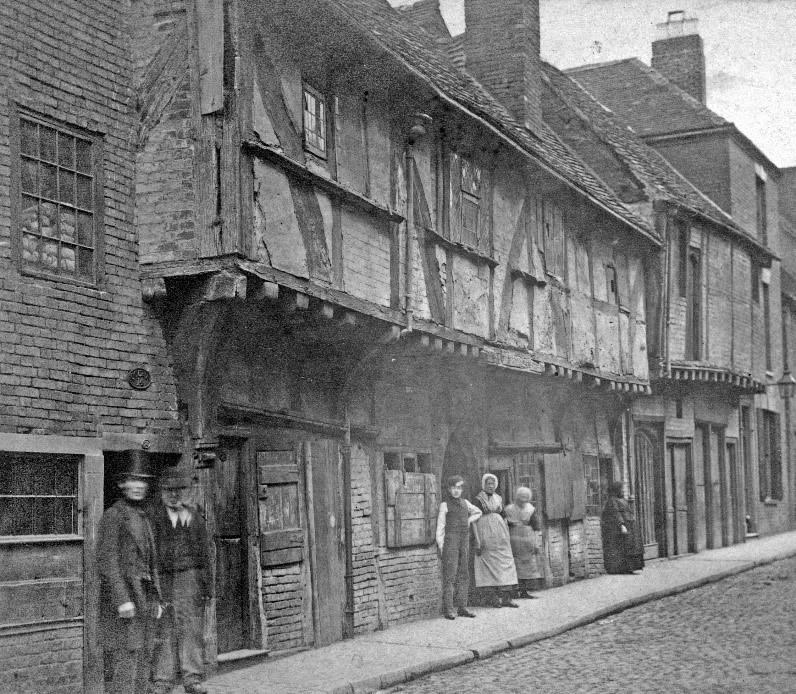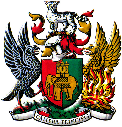| |
MelC
| 1 of 15 22nd Oct 2022 12:47pm Government Disposal Board (Click to see this topic in full)Hi there,
I am currently researching my husband's 2x great grandfather and in the 1921 census he was working as a police constable for Warwickshire Police at the Government Disposal Board in Foleshill. The occupation code is 809 - police:other rather than 808 which is for police officers. I have done a bit of digging but cannot find any information about what the Government Disposal Board is. If anyone can help tell me more about this place or what my husband's ancestor may have been doing in his work there I would be really grateful.
Many thanks
Melanie Caldicott |
| |
Helen F
| 2 of 15 18th Jun 2022 12:26pm Caldicott Research (Click to see this topic in full)Hi Melanie 
Not sure if any of it's helpful but there are a few references to Caldicott on the forum
Sometimes replies are a long time coming, so anything you can add here might temp someone to join and expand upon their part of the story. |
| |
Rob Orland
| 3 of 15 18th Jun 2022 12:09pm The Nugget Pub - Thomas Green (Click to see this topic in full)Hi Melanie,
Welcome to our forum, and thank you so much for your super posts.  And how sad about your g-g-g-g-granddad, I never knew about that.
Hopefully some of our members will be able to help you find out more about this, and the other subjects you've posts about - Eddie Weaver - Lord Mayor and Caldicott Research. In return, of course, we'd all love to learn more about these things, so if you'd like to share with us some of the research that you've done so far, it will be of great interest, and also help us to locate more specific information for you.  |
| |
MelC
| 4 of 15 18th Jun 2022 11:25am The Nugget Pub - Thomas Green (Click to see this topic in full)Hi everyone,
My 4th Great Grandfather was Thomas Green who was landlord of The Nugget Pub during the second half of the 19th century. There is a story about how in his early life he went to Australia as part of the gold rush and he then went on to name the pub. I have the passenger records for his trip.
He sadly took his own life at the pub aged 70, in 1889 by cutting his own throat. The newspaper articles which report his death also refer to his prospecting and how the pub got its name.
If anyone has any more information or can help me find anything else about the pub or my 4xGGF I would be really grateful.
Thanks
Melanie Caldicott |
| |
MelC
| 5 of 15 18th Jun 2022 11:01am Eddie Weaver - Lord Mayor (Click to see this topic in full)Hi there,
My great uncle was Eddie Weaver who was Lord Mayor of Coventry in 1982-83. I have some photos and have done some research about him, but would love to find out more if anyone has any information or memories.
Thanks
Melanie Caldicott |
| |
MelC
| 6 of 15 18th Jun 2022 10:58am Caldicott Research (Click to see this topic in full)Hi Everyone,
I run a One-Name Study for the surname Caldicott which involves researching all people who bear that surname. My husband is descended from the Coventry Caldicott silk weaver family and so I am familiar with some of the history surrounding the family. However, I would love to find out more about the Coventry Caldicotts or indeed anything about anyone with the surname if anyone can help.
Thanks very much,
Melanie Caldicott |
| |
Helen F
| 7 of 15 10th Jan 2021 12:40pm New Buildings (Click to see this topic in full)Hi Kaga,
The problem with answering your question is that a lot happened between the Victorians and the war. The second issue arises from the shape of New Buildings. It started at the end of Ironmonger Row which was a few buildings beyond the bottom of Butcher Row/Bull Ring at what is now Nandos. It then travelled a short distance to the Meriden Tavern where it split and half went north to Hales Street the the other half continued east to the bottom of Hill Top. Originally it went further east by a few houses but it had been cut short by the Triumph Works. The south side then remained much the same apart from one timber building being rebuilt and cosmetic changes to the fronts of the timber buildings of which the Meriden Tavern belonged. Shortly after the planners had started designing Trinity Street on paper, Triumph bought a U shaped set of 3 terraces on the north side, next to their gates and built another factory unit there. From there the north side of that branch and the east side of the northern branch running all the way to the fire station didn't change much until they built over the river and the war. Butcher Row and the north side of Ironmonger Row were demolished to build the top end of Trinity Street and Owen Owen. Then the rest of New Buildings to the west was demolished, along with the Smithfield Market, Becks Yard and the east side of Palmer Lane. Caldicott's and a few buildings north of it on the west side of Palmer Lane were still there in 1939 and I assume they were destroyed during the war, although that's not guaranteed.
As a reminder, this is the area looking south. New Buildings was at the top left, Palmer Lane on the right.

|
| |
Kaga simpson
| 8 of 15 21st Dec 2020 10:31am Swanswell Pool, White Street (Click to see this topic in full)Describing the original swamp land at Swanswell was really describing the 'slough' in the early thirties.
Coventry to me for the first ten years of my life was still Victorian, the old weaving factories were still there, Cash's, Caldicotts, Meteor - New Buildings, Butcher Row, Harnall Lane, the Hippodrome. Most groceries were still delivered by pony and trap, the streets used mostly by horses.
But the Swanswell had been altered in the Victorian days, it had been changed to a lovely park, the water now contained in an enclosed pool, |
| |
Helen F
| 9 of 15 12th Dec 2020 11:43am Trinity Street (Click to see this topic in full)Interesting Kaga. I don't think that the building in post 125 was Caldicott's original 1835 building although it could easily have been in the same area, long derelict, and part of the Trinity Street demolition. The one in the picture was built some time after 1897 and probably left the original empty. Had the company gone bust? In which case their new building may also have been vacated. That building wasn't needed for the construction of Trinity Street but for the building of Owen Owen so maybe Caldicott's ended up somewhere else in the city? What was Beck's originally, but was a varnish works by 1897, was nearby and was also demolished as part of the job to build Trinity Street.
The top end (south west) of Palmer Lane was owned by the Bablake School before Caldicott's was built. It started with a warehouse on the corner of Ironmonger Row and then there were 2 stables/small warehouses and a small house then a gap. The stables, the small house and the gap were where they built Caldicott's. |
| |
Helen F
| 10 of 15 17th Jul 2019 3:35pm Coventry's seasons of sickness (Click to see this topic in full)Thanks for this Victoria 
Below shows two pictures of the entrance to Caldicott Yard with my rough mock up of the buildings, placed on a digital copy of that bit of the Board of Health map. The maps are a true work of art. The top row looks west with the yard entrance to the right. That picture is by William Henry Brooke. The second row looks north with the yard in the gap to the left of centre. The picture is Anne's copy of a Troughton drawing.

It's hard to imagine the city before the overcrowding and the industrialisation that followed. It was positively village like by modern standards. Most houses had substantial gardens and took up a decent sized stretch of road. There were orchards and even farming within the city walls. At times of the plague some houses were even left empty for want of new lodgers and were ordered to be demolished if they became derelict. By the time the maps were drawn, many of the gardens had been filled with strips of tiny yard homes and the bigger gardens were being cleared for factories.
The most northerly point of Caldicott's Yard had a small mill that was powered by a spur of the Radford Brook. I suspect that it could only have run when Naul's mill was releasing water to power its own equipment.
|
| |
CovArchives
| 11 of 15 17th Jul 2019 2:02pm Coventry's seasons of sickness (Click to see this topic in full)In July 1849, Coventry established a local Board of Health and began to address the dismal situation of overcrowding, poor hygiene and disease that had become very much a part of everyday life in the city.
The new Boards had been created under the provisions of the Public Health Act of 1848 and one of its principal architects was Edwin Chadwick, who had also helped shape the provisions of the Poor Law some fifteen years earlier.
Chadwick believed that the best way to avoid the huge expense of providing relief for those who got sick was to improve the terrible circumstances in which they lived. He proposed that central government should take a much more active role in the provision of clean water and improved drainage; he also proposed that local councils be given the means by which to clear away refuse from homes and streets.
Coventry in the mid nineteenth century was a good example of Chadwick's argument: the city was dirty, overcrowded and prone to regular outbreaks of disease such as cholera. From the Black Death in the fourteenth century, to the Council's deliberations on how to "prevent the bringing of the plague and pestilence into this Citie" in the seventeenth (1), disease - despite all the attempts to combat it- was an inescapable part of life.
What exacerbated the problem in nineteenth century Coventry, however, was the rapid rise in the city's population. It grew by ten percent between 1838 and 1848, and although housing was being constructed, much of it was of poor quality. The Lammas and Michaelmas lands beyond the city's boundary could not be used for housing and private developers were building large numbers of houses in as small an area as possible to maximise the returns in rents; as a consequence, overcrowding and the problems associated with it became pressing issues.
William Ranger, appointed in 1849 to write a report on the state of the city's health (2) cites the example of a property in Caldicott's Yard (3) where he found "a man, wife, and five children, occupying a room twelve feet by six feet." This situation was by no means uncommon. With people crowded into such meagre living quarters, the rapid spread of disease was only to be expected.
But although the city had always been prone to outbreaks of scarlet fever and typhus, it was another epidemic of cholera that finally compelled Parliament to pass the 1848 Act. Opinion on what caused cholera varied from one medical authority to another, and so did the means by which to treat it. Those more inclined to trust in God rather than medicine could always turn to the "Special Prayer" recited at church services during cholera outbreaks, when the congregation would call upon the Lord Almighty for forgiveness: "thine unworthy servants... who turn to thee, their only refuge, in this season of sickness and great mortality" (4)
The City formed a Cholera Relief Committee in response to this fresh outbreak but a hundred people had died by the time it was properly up and running. The epidemic was eventually contained but it proved to be expensive: nearly four thousand people applied for relief and the cost of providing medicines, food, blankets, nurses, and gratuities paid to surgeons, came to nearly six hundred pounds.
The local Boards established at the end of 1840s were not without their limitations, but they did prove to be important first step in the safeguarding of public health. And more legislation was to follow, heralding further improvements. At Coventry Archives, the evidence of some of this early work has been preserved: one of the more remarkable artefacts is the Coventry Board of Health map, prepared by the Ordnance Department. A detail from it, showing Caldicott Yard as well as an image of alms houses at West Orchard, accompanies this post.
References:
1) Council Minute Book, 1635 - 1696, reference BA/H/3/17/2, Coventry Archives;
2) William Ranger, Superintending Inspector of the General Board of Health: "Report to the Public Body of Health on the City of Coventry," 1849, reference 352.4, "Green Box" C2c Public Health, Coventry Archives;
3) Taken to be the Caldicott's Yard at West Orchard, although there was another yard with the same name at Greyfriar's Lane. The image is taken from the Coventry Board of Health Map, reference SLA/2/4/3/16, Coventry Archives;
4) Pamphlet, "Cholera: Special Form of Prayer," reference JN 614.49, Coventry Archives
Board of Health Map 1851

Almshouses at West Orchard
 |
| |
Midland Red
| 12 of 15 9th Jan 2017 8:53am Yardley family (Click to see this topic in full)Neil - I don't know if this is one of your Yardleys?  Coventry Standard - Friday 24 November 1848
COVENTRY POLICE OFFICE.
Wednesday. Before R. K. Rotherham and R. Caldicott, Esqrs.
Edwin Dalton was convicted of violently assaulting a poor young man of the name of William Yardley, at the Ram public-house, on Saturday night last, where he went to sell a few nuts; and in default of paying a fine of 3s., and 11s. 6d. costs, he was committed to gaol for 14 days.
Coventry Standard - Friday 24 November 1848
COVENTRY POLICE OFFICE.
Wednesday. Before R. K. Rotherham and R. Caldicott, Esqrs.
Edwin Dalton was convicted of violently assaulting a poor young man of the name of William Yardley, at the Ram public-house, on Saturday night last, where he went to sell a few nuts; and in default of paying a fine of 3s., and 11s. 6d. costs, he was committed to gaol for 14 days.
Dalton was the son of the landlord of the Ram (Absalom Dalton) and he married my great-grand aunt Catherine Sadler  |
| |
dutchman
| 13 of 15 11th Aug 2016 11:12pm Spon Street (Click to see this topic in full)Yes it's gone, it was destroyed in the war. For most of the time before that it was occupied by Soobroy - confectioner. Before that it was occupied by Caldicott (poor rate collector) in 1874, Everitt (painter) in 1886 and Jephcott (plumber) in 1890. |
| |
Caldicott
| 14 of 15 17th Mar 2016 6:12pm Warwick Row and Greyfriars Green (Click to see this topic in full)An ancestor, by the name of Eusebius Caldicott, a retired ribbon manufacturer, died in 1882 at St Swithins Terrace, Greyfriars Green. I believe this was a terrace of houses which formed a southern boundary of Greyfriars Green, which was cleared away to build the infamous ring road. Do any photos of the Terrace exist? I have not been able to find it on the street maps published on the site. |
| |
InnisRoad
| 15 of 15 17th Mar 2011 8:01pm A E Feltham - City Press, Cox Street (Click to see this topic in full)Hi
My dad was bound apprentice to Caldicott and Feltham, of Ironmonger Row, in 1927. In that year, A.E. Feltham published "Coventry Past and Passing", by subscription only. My dad bound (or helped to bind) at least some of the copies. He had a special copy himself, bound in cream velum, which I loved to read as a child. Unfortunately, I lost touch with it after my marriage broke up in 1987, but I have recently acquired another copy in very good condition.
|
| |


 It's hard to imagine the city before the overcrowding and the industrialisation that followed. It was positively village like by modern standards. Most houses had substantial gardens and took up a decent sized stretch of road. There were orchards and even farming within the city walls. At times of the plague some houses were even left empty for want of new lodgers and were ordered to be demolished if they became derelict. By the time the maps were drawn, many of the gardens had been filled with strips of tiny yard homes and the bigger gardens were being cleared for factories.
The most northerly point of
It's hard to imagine the city before the overcrowding and the industrialisation that followed. It was positively village like by modern standards. Most houses had substantial gardens and took up a decent sized stretch of road. There were orchards and even farming within the city walls. At times of the plague some houses were even left empty for want of new lodgers and were ordered to be demolished if they became derelict. By the time the maps were drawn, many of the gardens had been filled with strips of tiny yard homes and the bigger gardens were being cleared for factories.
The most northerly point of  Almshouses at West Orchard
Almshouses at West Orchard

